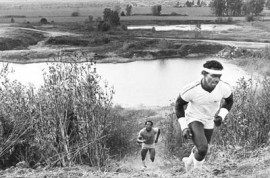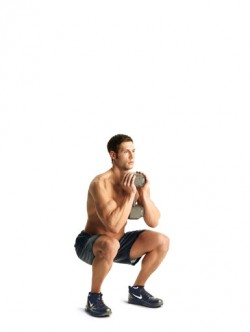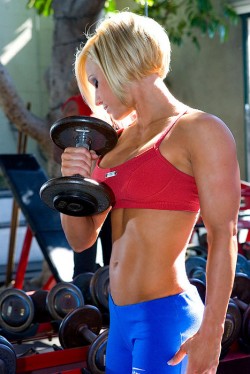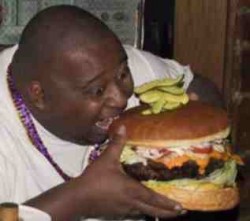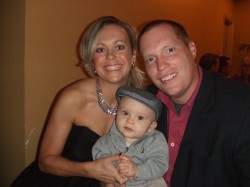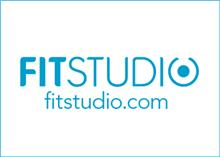More Personal Records… Bench Press and Hip Thrusts
June 27, 2013 by danny · Leave a Comment
I just got done giving basketball lessons to one of the teams that I’m working with this summer, and I’m about to head up to MVP Training for a couple training sessions. But I have a few minutes of spare time, so I thought I’d share a couple bad ass videos with you…
This first one is of Paityn hip thrusting some serious weight…
Want nice glutes? Do you want to improve your performance on the field/court? Wanna decrease your chances of knee/back injuries? If you answered yes to any of the above, then get good at performing hip thrusts!
Paityn’s goal on that set was 5 reps. She ended up getting 6. Looks like she’ll be going heavier next week! ![]()
Video numero dos…
Last week I mentioned HERE, that Liz had a bench press PR (personal record) of 105 before leaving college for the summer. Well, when she re-tested her bench with me a few weeks back, she set a new PR of 115. And just last week re-broke it with a 120 pound max.
So, props to Paityn and Liz for their hard work! Great work, ladies!!!
Well, this is the last weekend before 4th of July, and if you’re like most people, it may get a little ugly… pizza, beer, cake, snacks, etc. If that is you, make sure you make this weekend a good one in prep for the 4th.
I’ll try to get on here next week for a blogpost, but if I just get too busy, everyone have a fun and safe 4th!
Bench Press PR and My Thoughts On The Bench Press…
June 11, 2013 by danny · Leave a Comment
Liz, who plays basketball at Lehigh, set a bench press PR (Personal Record) of 105 pounds with her team when she tested before school ended back in May. Well, it was time to retest last week. And here’s how it went down…
New PR! Nice job, Liz! Her goals this summer include getting stronger/quicker/more explosive, as well as improving her ball handling and her ability to create space off the dribble. Her hard work at both our strength training sessions and our skill work on the basketball court (as well as all the time she gets to the gym on her own working on her game) has her heading in the right direction!
My Thoughts On The Bench Press
I did a video on my thoughts on the bench press as it pertains to most dudes.
Check it out HERE. Now, get to squatting, deadlifting, and hip thrusting!
Alrighty then, until next time…
TRULY HIIT
June 4, 2013 by danny · 2 Comments
Sorry that it has been so long since my last blog post. I’ve been spending a TON of time giving basketball lessons, training people, and changing poopy diapers. I promise to be back on here again soon though! As for today’s post…
Many people claim to be doing HIIT (High Intensity Interval Training) as a part of their cardio program. But in reality, few actually reach an intensity that I would TRULY consider HIGH intensity. If you honestly go ALL OUT like you are sprinting away from a hungry bear, then after about 12-20 seconds you would need over a minute to recover (maybe considerably more than a minute). If you do something like 20 seconds “on” followed by 20 seconds “off,” then you are not going as hard as possible during that 20 seconds… and/or not choosing an activity that makes you tired enough after 12-20 seconds (i.e. jumping jacks would be much easier than sprinting up a steep hill).
Quick Note: When I say “intensity” in this article, I’m talking about how fast you are going in regards to your max speed. In other words, if you do 20 seconds on, and 20 seconds off, you may truly be going as fast as you can, but due to the fact that you’ll be under-recovered going into the next set, you won’t be able to maintain your max speed from set-to-set.
Now, I have no problem with interval training where you do something like 20 on/20 off or 30 on/60 off, but don’t confuse that with TRUE HIIT. I’ll invent a new acronym right now (at least I’ve never heard it), M/HIIT… Medium/High Intensity Interval Training. This is much higher intensity than steady state cardio (like jogging 5 miles or doing a 15 mile bike ride), but nowhere near MAX effort followed by a full (or near full) recovery.
Think about it this way, let’s say you were being timed in a 100 meter sprint three times, and here were the 2 scenarios…
#1) Sprint 100 meters, rest 30 seconds, sprint another 100 meters, rest 30 seconds, and finally sprint one more 100 meters vs…
#2) Sprint 100 meters, rest 120 seconds, sprint another 100 meters, rest 120 seconds, and finally sprint one more 100 meters.
Obviously your times would be much faster with the longer rest intervals. This longer rest allows you to more fully recover, which allows you to run at an intensity closer to your max speed (like when running from that hungry bear).
Dr. Layne Norton and Dr. Jake Wilson talk about all the benefits of this truly HIIT in THIS PODCAST.
In short, HIIT (with the LOOOONG rest intervals) is a great way to hold onto muscle mass and strength/power gains while still getting your cardio in.
Just remember, you don’t rest a long(er) time just for the hell of it. You do so because you need to in order to repeat that HIGH intensity for the next set. Here’s an example of me doing plank-ups yesterday. I did this for 20 seconds, and in actuality I slow down a little bit towards the end and probably should have only done sets of ~ 15 seconds if I wanted to prevent my intensity from dropping towards the end of the set.
So, my advice for the individual that is looking to maximize muscle mass/strength/power but doesn’t want to get “too out of shape,” perform true HIIT for the majority of your cardio sessions (and if this is your goal, you shouldn’t be performing much cardio in the first place… maybe once per week).
If you are a “general fitness enthusiast” just looking to “be in good shape” and lose a few pounds, go ahead and perform a mix of true HIIT AND “M/HIIT.” And if you’re like me and can’t stand the long, slow stuff, never do it! If you enjoy that, go ahead and mix a little of that in there as well. You weirdo, you! Just kiddin’… kind of.
The best activities for true HIIT include (but are not limited to)…
- sprints
- hill sprints
- sled/prowler pushes or car pushes
- battling ropes
- plank-ups
- hitting the heavy bag
- heavy jump rope
- bike sprints (up a hill or on a stationary bike with the resistance turned up pretty high)
Now of course, some of these may not be appropriate for you depending you strength level (and injury history, etc).
Just remember if you are performing HIIT you will NEED a good amount of rest between sets, otherwise it is NOT truly HIIT. Both M/HIIT and HIIT can be incorporated into your plan if that fits your goals. Just make sure that you know the difference.
Now go get lean for the summer! ![]()
And if you know someone that says, “I’m heading to the gym for a HIIT session,” make sure you forward this article to them so that they too know the difference.
Have you ever performed true HIIT training? If so, you know that it ain’t for the faint of heart!
First Time Front Squatters and Squat Progressions
August 1, 2012 by danny · 8 Comments
If you want to improve your strength, power, and performance for a sport, squats are great! If you want to lose fat or gain muscle to help make you look sexier, squats are great. If you want to improve your mobility and stability, squats are great. The problem is, most people don’t take the time to learn how to perform them correctly.
My progressions with newer lifters usually look like this…
#1) Learn the goblet box squat
#2) Learn to goblet squat without the box to sit on (if that is “not working” go to #3, then come back and master #2).
#3) Learn to barbell box squat with the bar on your back
#4) Learn to front squat
#5) Learn to back squat
These phases are not set in stone and some people may never get to back squatting while others may be ready to back squat pretty much from the get-go.
This past week I had a few of my athletes (all basketball players) learn the front squat (and one is now just learning how to goblet box squat). It may take weeks or even months before going to the next step. The key is NOT to rush things. You’ll have plenty of time to get more advanced and add load. But MAKE SURE to learn how to squat the right way FIRST… then worry about adding load later.
The first video is of Liz and Michael…
Liz is preparing for her freshman year of basketball at Lehigh. We actually did barbell box squats today for the first time. Although she still has a little work to make them better, for her first time, she did very well. By the time she leaves for school in a few weeks, we’ll have barbell back squats down and I’m sure her Strength Coach at Lehigh will be pleased (as back squats are in their training program).
This was Michael’s very first set of front squats, and I thought he did very well. He is mobile/stable enough to get a couple inches lower (as I’ve seen him get that depth with goblet squats), but I didn’t want to force the range of motion on his very first set of front squats. Soon, he’ll be adding weight to the bar and be a stud!
Next up, Paige and Paityn…
Paige has already goblet squatted, back squatted and front squatted. She’s a pretty “natural” squatter. I took a little longer with Paityn because she has had a tendency to let her knees cave. So I didn’t want her front squatting and performing any more difficult squatting variations until she started to “nail” goblet squats and box squats. Well, she has gotten good at those variations, and for a first time front squatter, she also did very well. Like Michael, she has a couple inches of depth in her, and we’ll get to that next week.
Once you are ready (if ever) to deep back squat, John Alvino has a very good video with all the tips/cues necessary to become a good squatter…
There are so many benefits to squatting, but make sure to take your time progressing.
If this post has been beneficial to you, please hit the “like” and “tweet” buttons. Thank you!
Training Videos From The Week That Was – Part II
July 6, 2011 by danny · Leave a Comment
I hope everyone had a great 4th of July. Although I’m sure you all enjoyed a beer and a burger (I know I did), I hope you still managed some holiday training!
My parents were in town from Illinois to meet their grandkids. We had them and a few friends over to cookout, swim, and do a little celebrating. But before that took place, me and my clients made sure we got work done in the gym! …
Here is Coco doing push-ups with a pause in the bottom position. The goal was to perform 5 reps at a tempo that made it so the 5th rep was very tough. This was her first set, so she was just “feeling out” the proper speed. In the sets to follow, she actually went slower on the way down, and paused longer in the bottom position.
It had been awhile since I tested chins for max reps. So I woke up Sunday morning, met some of the high school kids at the gym, and got a training session in with them. The end result…
BTW, my abs were killing me the next day. NOT the 1st time that has happened after a touch chin/pull-up day. Just goes to show you how much the abs are working during a properly executed chin!
Dumbbell holds are up next. This is the last exercise the b-ballers perform before calling it a week in the weight room. I like to have them finish with an exercise that challenges their mental toughness a little bit. It also builds a little team camaraderie as the kids quite often heckle/raz/push/encourage one another when their teammate’s turn is up. Fun to watch too!
Brandon performs 3 chins with 55 pounds added…
Coco does a set of RDLs with 135 pounds for 8 reps. She always does a great job, but I’m still trying to get her to keep her head neutral (in line with her spine), and I’d like to see her back with a little bit of a tighter arch. Hey, I am aim for perfection, what can I say. ![]()
Jerome performs dumbbell incline presses…
I’ll leave it there for now. Check back for more videos in the weeks to come.
Don’t forget, you can follow me on Facebook and Twitter. Have a great, healthy week!
How To Increase Athleticism
March 28, 2011 by danny · Leave a Comment
I just had an article published by my peeps at Sears titled, “How To Increase Athleticism.” How do you increase athleticism? Is improving your skill and increasing athleticism the same thing? I think not. To get my take on how to increase athleticism in more detail, read on my friend…
I’ve Lost A Lot of Fat, BUT, I’m weaker. Please help!
March 8, 2011 by danny · Leave a Comment
The other day, my good friend Matt Brewer sent me the following e-mail:
“Quick questions – I’ve been busting ass in the weight room ever since I was in Las Vegas and continued to do so after my return to Omaha, but when Megan got pregnant I ate whatever she had a craving for and gained an enormous amount of weight. At the same time I was getting stronger and stronger but fatter and fatter. I hate using bench press as a bench mark (like what I did there?) for strength but for this purpose it works: I was repping out 315 x 5 for my last set but my gut was carrying around 220 pounds.
Last summer/fall Megan and I got our crap together and started eating right. I felt that if we are going to raise a healthy kid we might as well start with ourselves and get healthy first to serve as a good example for him. Since then, I’ve lost 45 pounds and am currently weighing in between 174-176 pretty regularly. I incorporate cardio and still do a lot of strength training. I haven’t changed my routine a whole lot; only changed what I was shoveling in my mouth.
One thing I’ve noticed though is my strength has gone down significantly. I’m not starving myself, but I just don’t seem to have that ‘pop’ when pressing weight out. Do you think the significant weight loss has had a direct effect on my strength and if so, how do i get it back without packing on the fatty pounds? I’m just wondering if I need to consume more calories so my body isn’t eating up muscle tissue for energy.
Thoughts? Funny comments? Jokes about my tubbiness?”
My response:
First of all Brewer, I’m glad to hear that you and Megan are now setting a good example for your little one. This out of shape/obesity problem that we have in America, starts with the parents. After all, the parents are the ones that bring the food into the house! Too, kids are very impressionable, so it is important for your son to see you both living a healthy, active lifestyle. Keep it up Megan and Shrew Dog!
And now, to answer your question:
Think about it this way: let’s say that when you were 220 lbs, you were 20% body fat (for the sake of easy math). That means that even know you were carrying 44 pounds of fat, you were also carrying 176 pounds of lean body mass (much of which is muscle). Now, at about 175 lbs, let’s say you are down to 10% body fat. That means that you are carrying about 157 pound of lean body mass. So, even know you are now prettier, healthier, and more athletic, you are not going to be able to lift as much with this reduction in lean body mass. This is why you’ll see many fat powerlifters – they purposely put on as much weight as possible so they can lift as much as possible. Make sense?
So, part of the problem of not being able to lift as much, is just something you’re going to have to deal with. IMO, the pros greatly outweigh the cons. BUT, if you time your carb intake around your workout (peri-workout), you can get that “pop” back that you mentioned you no longer feel. So, eat healthy carbs pre/during/post workout and try to minimize carb intake the rest of the day. You could just eat healthy carbs pre and post-workout with some protein… sweet potatoes + chicken OR rice + grass-fed beef etc. I NEED to eat during my workout, or I lose that “pop.” So, I go with organic raisins + whey protein powder during the workout, or Surge (from t-nation). But you don’t necessarily need this if you feel full of energy with the pre-workout carb + protein meal (which should be eaten 45-60 minutes prior to workout – depending on how BIG of a serving you eat).
Finally, once you start to time your carb (“energy” meals) meals around your workout and your body adjusts to heavy lifting at this reduced body weight, you may just be able to get back to the strength levels that you enjoyed when you were 220 lbs. Keep at it and continue the great work buddy!
FitStudio + Heavy Female Lifting
February 23, 2011 by danny · Leave a Comment
In case you didn’t know already, I’ve been doing some writing for FitStudio. I am one of the contributors at fitstudio.com and you can find my blogposts right here. So far, here is what they have up;
-Changing Exercises Isn’t Enough - Most people do the same exercises each time they hit the gym. Changing exercises is a good start, but not enough for optimal results.
-Even if fat loss is your MAIN goal, does strength matter? Guess what my answer is… Strength Matters - Part I.
-Obviously strength is very important for sports like football, but what about for endurance sports. Check out my take… Strength Matters - Part II.
Check back in with FITSTUDIO as they will be adding more of my stuff each week!
Just thought I throw this in real quick. My client, Coco, tossed around some heavy weight the other day. This is her doing rack pulls for 205 X 6. She ended up hitting 215 pounds later on in the workout, and made it look pretty easy.
And what do you know? She is lifting some heavy weight and nowhere near BIG and bulky “like a man.” Each week her arms, shoulders, and back are looking more and more “toned.”
What do you say Coco, 225 pounds next week? Sounds about right to me.
Don’t forget, you can follow me on twitter @dannymclarty.
Should Your Max Always Be Your True Max?
August 23, 2010 by danny · Leave a Comment
The other day I worked up to a 2 rep max (RM) with trap bar deadlifts. After I finished the 2RM, I could have “easily” (ok, not easily, but I certainly left some weight on the table) added more weight and gotten a higher 2 RM for the day. And no, I’m not acting like the typical internet forum hero and making claims that have no truth. Here’s the video for proof…
That is 405 pounds X 2. *** While certainly no world record, it is not bad since I currently weight just under 160 pounds (“bulking season” is just around the corner however ![]() ) After I finished rep #2, I felt as if I could have done another 2-3 reps, or done another set and added at least another 20 pounds to the bar and continued working up to my 2 RM for the day. I decided to do neither. At this point in my life, in my opinion, it is not worth it. I’m 34 now, and my main goal is to have a buff, healthy body. If I were to continue working up to a higher weight, only to round my lumbar spine and herniate a disk, I’d be very pissed at myself. If I continued to work up to a heavier weight for the next 4-5 weeks in my program, and hit 450 X 2, or 475 X 1 (or whatever), would I really be healthier and more buff? Maybe, maybe, maybe a touch bigger. Every exercise we do in the weight room has a risk:reward attached to it. Going for a number considerably bigger than 405 X 2 on deadlifts to me, is riskier than what the reward would bring. When doing deads, my goal is to go as heavy as possible while having perfect, or near perfect form on every rep. If you look at the video, I think my form is good for lifting a weight that is more than 2.5 times heavier than I am. But it is not perfect. (And how much sloppier would it get if I were to continue working up to a higher max?) I slightly extend my neck as I lift the bar off the floor. And my hips rise SLIGHTLY before my shoulders but overall, I’m happy with the lift. Certainly much better than many deadlift attempts that you’ll see out there…
) After I finished rep #2, I felt as if I could have done another 2-3 reps, or done another set and added at least another 20 pounds to the bar and continued working up to my 2 RM for the day. I decided to do neither. At this point in my life, in my opinion, it is not worth it. I’m 34 now, and my main goal is to have a buff, healthy body. If I were to continue working up to a higher weight, only to round my lumbar spine and herniate a disk, I’d be very pissed at myself. If I continued to work up to a heavier weight for the next 4-5 weeks in my program, and hit 450 X 2, or 475 X 1 (or whatever), would I really be healthier and more buff? Maybe, maybe, maybe a touch bigger. Every exercise we do in the weight room has a risk:reward attached to it. Going for a number considerably bigger than 405 X 2 on deadlifts to me, is riskier than what the reward would bring. When doing deads, my goal is to go as heavy as possible while having perfect, or near perfect form on every rep. If you look at the video, I think my form is good for lifting a weight that is more than 2.5 times heavier than I am. But it is not perfect. (And how much sloppier would it get if I were to continue working up to a higher max?) I slightly extend my neck as I lift the bar off the floor. And my hips rise SLIGHTLY before my shoulders but overall, I’m happy with the lift. Certainly much better than many deadlift attempts that you’ll see out there…
Your Goals, Your Call
If you think I’m being a big wuss for not really caring too much about not getting my deadlift up considerably higher, that is fine. And if your goal is to deadlift as much weight as humanly possible, I am completely cool with that. I get it. Lifting heavy weight is definitely an important component to having a muscular body. That is why I have worked up to deadlifting over 400 pounds. But I am not competing in powerlifting and again, adding some lbs to the bar in this lift won’t do a ton to making me more jacked. Even Eric Cressey, a former competitve powerlifter who has a deadlifted over 600 pounds has stated this in an article…
Category 1: Weekend warriors who deadlift to improve functional capacity and correct or prevent imbalances.
Category 2: Athletes who deadlift to improve performance and bulletproof themselves against injury.
Category 3: Powerlifters who deadlift to get better at deadlifting.
Logically, I’m willing to take more chances in category #3 than I am in #2, and certainly #1. Weekend warriors don’t get aggressive loading parameters (singles over 90%). And while athletes might get to pull heavy singles, they only get to do so in a controlled environment (elevated trap bar deadlifts, pulls against chains).
A veteran athlete would blur the line between #1 and #2, and a more resilient up-and-coming athlete would be more of a “true” #2.
According to Eric’s categories of deadlifting, at this point in my lifting “career,” I put myself in category #1, merging with category #2, as my competitive juices get flowing sometimes and I can’t help but “really going for it!” But I’m certainly not willing to go into category number 3 just to add a few pounds to the bar.
Other Lifts
There are plenty of other lifts out there where going ALL OUT with weight carries a much smaller risk. And on those lifts I often work up to a true max (and have my clients do the same), whether that means a 1 RM, 8 RM, or any other rep range that I am working in. For example, the other day I worked up to a 1 RM with chin-ups. I hit 100 lbs X 1…
Later on in that same training session I did some hammer curls…
If I ended up picking a weight that had me falling a little short on that chin-up (missing a lift – rarely, if ever a goal), I think my injury status would still = healthy. Same thing with exercises like curls.
Moral of the Story
I hope you don’t think I am saying that you should not try to get stronger in certain lifts, like the deadlift. Getting a big(ger) deadlift will do wonders for your physique. But with certain lifts, I want you to ask yourself how important it is to really go for a true max. While in other exercises, pushing it to a true max is probably worth it. Only you can answer the importance of what category you put each lift in within your training goals. As I get older, I get smarter and am comfortable of knowing when to hold back a touch, and when to completely go for it.
*** Like I mentioned, 405 X 2 is not a world record. But it is a world record for the most weight ever lifted while listening to John Mayer. What the hell was that!?!
The Coaches That Have Influenced Me The Most
August 2, 2010 by danny · 4 Comments
Then one day at Gold’s there was a flyer that was put up at the front desk. It said something like, “Cy Willson will be holding a seminar, talking about nutrition and supplementation.” I couldn’t wait to attend, as Cy had a reputation around the gym as a very smart guy. Plus, I could now get some of my questions answered, and most likely confirmed (so I thought). I pulled up a chair to listen to Cy speak. I couldn’t wait to learn a few new things, and again, confirm that my training and nutrition “plan” was pretty much on the money. By the end of the seminar, my head was spinning, and I realized that I didn’t know sh*t about sh*t! I learned a bunch of new words, like whey and casein, heard about nutrient timing for the first time, and listened to Cy dispel a bunch of myths that I didn’t even know were myths. When I walked out the door of the room the seminar was being held in, I was very frustrated, and a little embarrassed that I ever offered even a single bit of training and nutrition advice to the people that had asked me for help over the years.
At the time, Cy was writing for a website called testosterone magazine. In the seminar, he told us that we could all become experts if we started to follow it and to soak in as much of that information as possible. So I got home, hopped on the computer, and started to read some of the articles. I read articles by John Berardi, Cy, Ian King, and Charles Poliquin. And I had no idea what they were talking about. Wait, what is this “hypertrophy” word they keep bringing up? And are hormones like insulin and testosterone really that important? According to these experts, it seems like they are. But why? I just don’t get it. I started to think, maybe this whole personal training thing just isn’t for me. After all, the only reason I ever got better than D’s and F’s in school, was so that I could stay eligible for basketball. Everyone knew school and studying wasn’t really important to me. I’d much rather be lifting weights, playing basketball, or going to the beach. But I knew lifting/working out would be a big part of my life for a long time. I loved it. And I couldn’t go to the gym and “not really know what I was doing.” So I decided to buckle down and really try to learn from these people at that website. I went up to Cy at the gym and asked him if he’d meet me so I could ask him some![]() nutrition questions. He was very nice and said, “sure, no problem.” So I headed back to testosterone magazine and spent hours reading his articles, as well as articles by the other authors. I took a bunch of notes and was going to be prepared for the day when Cy and I were to meet.
nutrition questions. He was very nice and said, “sure, no problem.” So I headed back to testosterone magazine and spent hours reading his articles, as well as articles by the other authors. I took a bunch of notes and was going to be prepared for the day when Cy and I were to meet.
I still remember, I had a list of 18 questions put together for him. I thought to myself, “if I can just get Cy to help me understand these questions, I will basically have this whole nutrition thing down.” And let me tell you, these questions weren’t the most advanced questions by any means. The average question looked something like this; “in one article, it says that beef is good for you, but in John Berardi’s article, he says that we should avoid burgers. What’s the deal?” Cy said something like, “John is probably referring to greasy burgers, like the ones you find at McDonald’s. If you eat a lean cut of beef, it is good for you. Especially if it is grass fed.” I was like, “great, I can check that off of my list. Only 17 questions left and I will know all I ever need to know!” Anyway, as I got deeper into the field, I found out that the more I learned, the more I realized I didn’t know. It was about at this time, that I became obsessed with learning as much as I could. So much so that I quit teaching and started training full time. My dad was shocked. For him (back in middle and high school), trying to get me to turn off ESPN in order to get me to study, was like pulling teeth. And now, I was spending more time with my face in the books than ever before… and then some.
My journey as performance coach, personal trainer, strength coach (whatever you want to call me) began with Cy Willson, and it continues today. Below, are the people that have influenced me the most. They are grouped in chronological order. The first group is the first wave of experts that I learned from early on. As you move down the page, you’ll see the next wave of people that I learned from, all the way down to the most recent coaches. Just because Charles Poliquin (for example) is in the first group, it doesn’t mean that I don’t still learn from him. He is listed in the first group only because that is the time when I first started reading his work.
Cy Willson – you heard about Cy above. Even know that I’ve thanked him for helping me learn in my early days as a trainer, I don’t think he knows how thankful I truly am for all of his help. Besides attending two of his seminars at Gold’s, and that time that he met up with me to help answer those 18 questions, he also responded to every one of the countless e-mails that I sent him over the years. I’m VERY appreciative of this!!!
Dr. John Berardi – before Dr. Berardi had ever written a book, or was in position to influence hundreds of thousands of people, like Cy, he was answering many of the e-mails that I sent him back in the day. Cy and John really are the two that got the fire burning for me.

Ian King - Ian and Charles Poliquin were the two that first got me interested in learning all I could about weight training.
Charles Poliquin - See Ian King above.
Moving on a little later in time, to the next group of trainers that have had a huge influence on all I’ve learned over the years..
Eric Cressey – Like Dr. Berardi and Cy Willson above, Eric was very generous with helping me out early on. I definitely still learn a ton from EC today!
Joel Marion - I first read Eric and Joel’s work in the old “Ruggedmag.com” website. It is no longer a ’site, but like t-nation, I looked forward to the articles they would publish each month.
Mike Robertson – Mike did a lot of his early t-nation writing along with Eric, and I learned, and still learned a ton from him.
Dave Tate – I bought the “Westside Seminar Video” many years ago, and it exposed me to powerlifting. I belive Eric Cressey referred me to this DVD set after I e-mailed him asking him where I should go to learn more about training a powerlifter that just hired me. She went on to set many personal records and it felt great helping her out!
Christian Thibaudeau – When I first read Christian’s work I loved it. He offered info and experience from the Olympic Lifting side of things, as well as a lot of great bodybuilding info.
Chad Waterbury - While I don’t agree 100% with everything Chad has written over the years, he has made me think and I definitely incorporate some of his methodology when writing client’s programs (and my own programs).
David Barr
Mike Boyle - Anyone that cares about getting better in this field has learned a thing or 257 from Coach Boyle.
Alwyn Cosgrove - Has influenced many.
Jason Ferruggia
Dr. Clay Hyght -Dr. Clay moved to Cali. a few years ago. We started working together and became friends. As you can see, I have a large number of people listed as those who have influenced me, so I obviously don’t prescribe to only one person’s training methods. But if I was maybe starting to lean a little too far to the “train movements, not muscles” side, Clay bitch slapped me back in line. While I don’t think that strictly training movements is wrong, it’s not completely right either. To me, it is about when to bring out which tool for the client. That may be using O lifts at certain times. It may mean using a powerlifting type of template, or it may mean using “bodybuilding” training at certain times. The answers always seem to be somewhere in the middle (in any aspect of life). Which is why I wrote this article sometime back… “Change it Up and Stay Motivated”
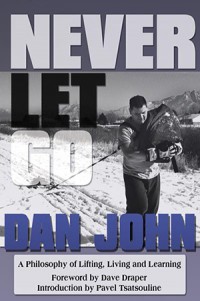
John Romaniello – I believe John was among those that were writing for ruggedmag years ago. I remember liking his work, and then didn’t hear anything from him for quite some time. Well, he’s back with a vengeance. Over the last year he has published many article and come out with a book.
Mike Roussell …
Jimmy Smith …
Nick Tumminello - Since the first NT article I read, I can’t get enough of Nick’s work. He is very smart and does a great job of clearly communicating his knowledge!
Brian St. Pierre - Great nutrition info. He gives logical reasoning for all of his opinions and never seems to go too far to one extreme or the other.
Lyle McDonald
Tony Gentilcore - I love Tony’s writing. Very informative, and very entertaining!
Gray Cook …
Mak Young…
Alan Aragon…
Bret Contreras - Bret is a going to be a name that we’ll be hearing about for years to come. And I have a feeling he’ll be on the short list of many trainers, as one of their biggest influences. If you want to build a nice booty, get to know Bret’s work.

If I had to pick just 3 or 4 from each “era” that have have influenced me the most, here’s the All-Star line-up
Danny’s “Golden Era”
Cy Willson
Dr. John Berardi
Ian King
Charles Poliquin
The First “Next Era”
Eric Cressey
Mike Robertson
Christian Thibaudeau
The, I Can’t Think of a Cleaver Name, Era
Mike Boyle
Alwyn Cosgrove
Dr. Clay Hyght
Jason Ferruggia
My Newest Breed of Influences
Tony Gentilcore
Bret Contreras
Nick Tumminello
Brian St. Pierre
I wonder what my list will look like in 2020. Thanks to everyone that has helped me over the years! I try to give as much back as I can to youngsters looking to get in the field, and/or people that are simply looking to improve their health and physique. And with the help from the people in the list above, I am now better equipped to answer the question, “bro, like what I gotta do to get some huge pecks dawg?”


